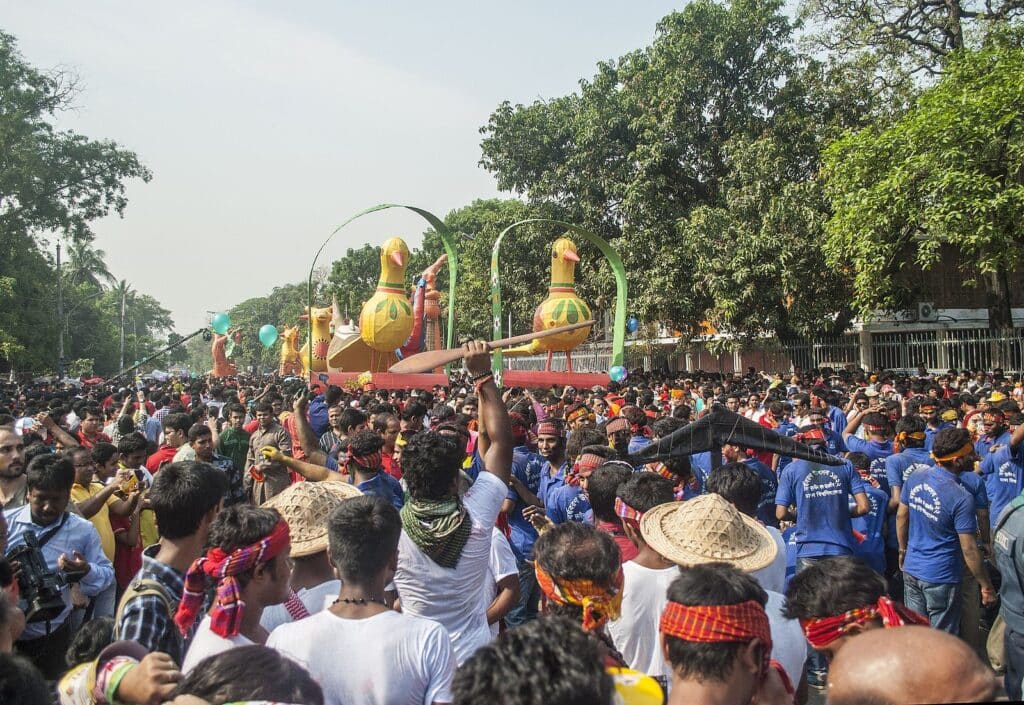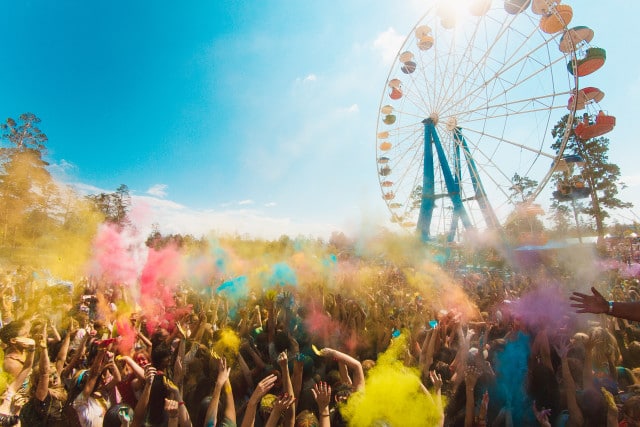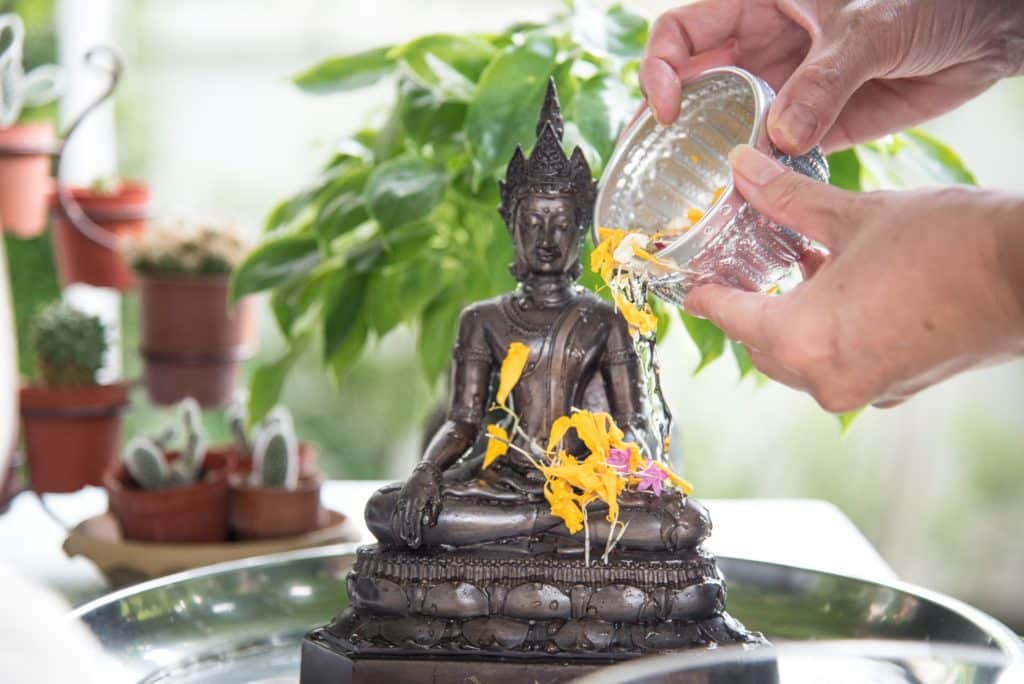Springtime is a season of rebirth and celebration. Spring festivals around the world celebrate this spirit of renewal and new beginnings.
We’re inspired by Remitly customers across the globe who celebrate their own springtime traditions, from Bengali New Year to Ramadan to Semana Santa. Read on to learn more about major spring festivals, from the world’s biggest water fight to parades full of color, and find out how people participate in them.
Bengali New Year
Where it’s celebrated: Bangladesh and Western India
Bengali New Year, also known as Pahela Baishakh, is the first day of the Bengali calendar, the official calendar of Bangladesh. The spring festival has a close association with the spring harvest.
Bengali New Year is primarily celebrated in Bangladesh on April 14th and in West Bengal, Tripura, and Assam in India on April 15th. People celebrate this holiday with processions (Mangal Shobhajatra), fairs (Boishakhi Mela), gift-giving, spending time or visiting with friends and family, and songs and dancing.
People of Bengali heritage living in other countries may celebrate the festival by sending money or gifts to loved ones back home.

Buddha’s Birthday
Where it’s celebrated: East and South Asia
Buddha’s birthday is celebrated in most of East and South Asia, commemorating the birth of Prince Siddhartha Gautama, the founder of Buddhism. There are many branches of Buddhism, and each one has its own celebrations to pay respect to the deity in honor of his birthday.
The exact date of Buddha’s birthday is based on the Asian lunisolar calendar. It is primarily celebrated in the Baisakh month of the Buddhist calendar and the Bikram Sambat month of the Hindu calendar. As a result, it typically falls in April or May each year.
During the spring celebration, Buddhists may hang lanterns and throw parades. People gather with loved ones to share communal meals, and a visit to the temple to make an offering is customary.
Dia dos Namorados
Where it’s celebrated: Brazil
The Brazilian people celebrate Dia dos Namorados in a similar way to how many other parts of the world celebrate Valentine’s Day. The main difference is the date.
Across the world, Valentine’s Day falls on February 14th. In Brazil, Dia dos Namorados falls on June 12th, making it a late spring festival. The timing is due to its proximity to St. Anthony’s Day on June 13th.
Brazilian couples celebrate Dia dos Namorados by exchanging romantic gifts, spending the day together, and going out on special dates, such as enjoying Brazilian food at a restaurant.
Easter
Where it’s celebrated: Worldwide
Easter is a major holiday in the Christian religion in the southern and the northern hemisphere. Easter is the day Christians recognize the resurrection of Jesus Christ from the dead.
Different Christian faiths celebrate Easter on different days. Catholics and most Christians around the world celebrate Easter on the first Sunday that occurs after the first full moon following the spring equinox of the Gregorian calendar, which occurs on March 21. As a result, the date can fall in late March or early April.
The Orthodox Church uses a different calendar called the Julian calendar. According to it, the vernal equinox falls on April 3rd, meaning that Easter is celebrated on the first full moon after Passover.
People in Bulgaria, Cyprus, Greece, Lebanon, Macedonia, Romania, and Russia primarily celebrate Orthodox Easter. Observers of Easter primarily celebrate the holiday by attending a church service on Easter Sunday and then eating a large meal with family and friends.
Celebrations may begin on Good Friday when Christians remember the day Jesus was crucified. Some people don’t eat meat on this day in remembrance of his sacrifice. Churches may also hold masses or religious services on Easter Monday in some cases.
In the United States, the White House hosts an Easter Egg Roll. Easter eggs are hard-boiled eggs that have been dyed with a solution of colored powder or food coloring and vinegar.
At the Vatican, one of the largest crowds of the year gathers in St. Peter’s Square to watch the Pope bless an icon of Christ and to hear his message.
Hanami
Where it’s celebrated: Japan
Japanese celebrate Hanami, also known as the Cherry Blossom Festival.
The cherry blossom, or sakura, is the national flower of Japan and the spring.
The emergence of the flowers marks the end of winter and spring’s arrival. Due to their quick blooming season, the sakura represents the transience or fleeting nature of life, which is a major theme in Buddhism.
For the few short weeks that cherry blossoms are at their peak, people from all over the world make the trip to Japan. Due to its popularity, similar cherry blossom festivals are now widely celebrated across the world.
Holi

Where it’s celebrated: India
Holi, also known as the Festival of Colors, represents the arrival of spring, the spring harvest, and the triumph of good over evil. Although holidays like Christmas have become popular in India, Holi remains one of the most significant festivals of the year for Hindus. People of other faiths may also celebrate it in India.
Per Hindu mythology, the demon king Hiranyakashyap was given a reward that made him immortal, and he wanted to be worshipped as a result. However, his son, Prahlad, was a devotee of Lord Vishnu.
Angry that his son didn’t worship him, the king asked his sister Holika to sit in a pyre while holding his son. While sitting on the fire, Holika died, but the king’s son was saved by Lord Vishnu.
Lord Vishnu later killed the demon king Hiranyakashyap. The evening before Holi is known as Holika Dahan or Chhoti Holi. On this night, people follow the ceremony of lighting bonfires to signify the burning of the demon Holika in accordance with Hindu tradition.
People celebrate Holi by splashing water and smearing each other with colors known as Gulal. In modern-day India, this is often done with water balloons.
Holi is celebrated during the month of Phalguna in the Hindu calendar, and festivities start the evening of Purnima. As a result, this spring festival generally takes place in March.
Holi is now widely celebrated anywhere with a large Hindu population, such as Suriname, Fiji, Guana, Mauritius, Nepal, Pakistan, Bangladesh, Trinidad and Tobago, Indonesia, the United States, the UK, Canada, and Australia.
Nowruz
Where it’s celebrated: Central Asia and the Middle East
Nowruz means “new day” in Persian. It welcomes spring with a festival held on the vernal equinox on March 21st. The holiday dates back more than 3,000 years, with people holding spring celebrations for the occasion everywhere, from the Balkans to the Black Sea to Central Asia and the Middle East.
Not a religious holiday, Nowruz is a universal celebration of new beginnings, wishing prosperity to others, and greeting the future.
Some Nowruz traditions include the “Haft Sin” table, which includes seven items starting with the Farsi letter “S.” Although customs vary, the items generally are a candlestick and candle, goldfish, hyacinth flowers, a Persian poetry book, painted eggs, a mirror, and pastries. These things symbolize hope, health, wealth, and prosperity in the new year.
Many people celebrate by cleaning their homes, visiting friends and neighbors, and sharing meals.
On the last Wednesday of the year (Chaharshanbe Soori, or “Red Wednesday”), the entire neighborhood may gather in public spaces to jump over fires, sing traditional songs, and repeat the phrase: “Give me your beautiful red color and take back my sickly pallor!”
Passover
Where it’s celebrated: Worldwide
Also called Pesach, Passover is a major Jewish holiday celebrating the exodus of the Israelites from slavery in Egypt and the “passing over” of forces of destruction.
The date of Passover is not set by the Gregorian calendar. Instead, the lunar Hebrew calendar determines the timing. The celebration takes place on the 15th day of the Hebrew month of Nisan, so it happens sometime between March 26 and April 25.
For Jews, the Passover festival typically lasts for seven or eight days. During this time, several important rituals and cultural activities occur.
One of the most important Passover rituals is removing all leavened food products (chametz) from homes and abstaining from them during the holiday. On the first two nights of Passover, families and friends gather for a religious feast known as a seder. While the story of the exodus is being told, various rituals corresponding to aspects of the narrative are performed.
Ramadan
Where it’s celebrated: Worldwide
Ramadan is a Muslim celebration during the ninth month of the Islamic calendar. It marks the time when the Qu’ran is believed to have been revealed to the prophet of Islam, Muhammad.
For Muslims, Ramadan is a period of introspection, communal prayer in the mosque, and reading of the Qu’ran.
Fasting during the month of Ramadan is one of the Five Pillars of Islam and is a time for self-restraint. Muslims who observe this religious tradition spend the daylight hours fasting. Fasting is broadly interpreted as an obligation to refrain between dawn and dusk from food, drink, sexual activity, and immoral behavior.
At the sunset prayer, Muslims gather to break their fast with a meal called iftar that is shared among friends and extended family. Traditional foods for Ramadan vary across the world, but regardless of what’s served, the meal is an opportunity for loved ones to spend time with one another regularly during the multi-day festival.
Semana Santa
Where it’s celebrated: Latin America and Spain
Semana Santa translates from Spanish to English as “Holy Week” and is a major holiday in Central and South America. It is an annual week-long festival where thousands of people take part in elaborate parades and processions.
The annual festival starts on Palm Sunday (the Sunday before Easter), and the final night is on Easter Sunday. To celebrate the occasion, you’ll often find daily Path of the Cross processions through city centers.
Guatemalans observe the holiday by decorating the streets with flowers. In Nicaragua, intricately decorated boats sail around Lake Nicaragua. For the Mexican carnival held in honor of the Semana Santa, major cities get decorated with flowers, and many people take vacations.
Sham El-Nessim
Where it’s celebrated: Egypt
Sham El-Nessim is a national holiday in Egypt, marking the beginning of spring. Both Christians and Muslims celebrate the holiday, which falls on the Monday after Easter.
Sham El-Nessim dates back to 2700 BCE when ancient Egyptians would celebrate the spring season. To celebrate the day, Egyptians head out to natural areas such as parks, gardens, or zoos with their families and enjoy traditional foods like salted fish, onions, and eggs.
In addition, families celebrate by coloring and decorating eggs in various patterns, a traditional activity of ancient Egyptians, as eggs are symbolic of new life and new beginnings.
Songkran Festival

Where it’s celebrated: Thailand
In Thailand, Songkran celebrates the Buddhist New Year and the beginning of spring with a massive water-throwing festival where people splash chilled water on others in the crowd. Water symbolically washes away the previous year and prepares people for the new one.
The six-day celebration typically takes place in April, and people observe it in many ways throughout the country. However, family and friends get together across Thailand to honor the elders and welcome prosperity into the new year with the water as a means of expression.
Many families also celebrate the water festival time by cleaning their houses and other public spaces and visiting Buddhist temples.
Cooper’s Hill Cheese Rolling
Where it’s celebrated: Gloucester, England
There are many spring festivals around eggs, but in Gloucester, England, cheese is the way to celebrate the new season of spring.
The tradition dates back to at least the 19th century, when residents of the town began climbing to the top of a steep hill and attempting to roll large cheese wheels down.
It’s way more difficult than it sounds. The cheese used weighs 3 to 4 kilograms and can reach speeds of up to 70 miles per hour as they roll. After the race, people typically remain at the site of the rolling, socializing, and ringing in spring.
Canadian Tulip Festival
Where it’s celebrated: Ottawa, Canada
Held every spring, the Canadian Tulip Festival commemorates the sacrifice of 7,500 Canadian soldiers that participated in the liberation of The Netherlands from the Nazis during World War II.
After the war, the country donated tulip bulbs to be planted in Canada as a sign of gratitude from the Dutch and the friendship between the two nations. Each year, over a million tulips bloom in Ottawa during the spring.
For 11 days in May, Commissioner’s Park hosts a festival to encourage people to come and see the tulip garden. Walking tours are available, and some markets sell food and tulip bulbs for those who want to continue the tradition of planting flowers at home.
Celebrate Spring around the World
No matter where you live, you can likely find celebrations of the changing seasons that take place at the end of winter and on or around the first day of spring.
